Reading: Difference between revisions
m clean up, typos fixed: However → However, |
|||
| Line 44: | Line 44: | ||
===Dissolution and war=== | ===Dissolution and war=== | ||
The Abbey was largely destroyed in 1538 during the Dissolution of the Monasteries. The last abbot, Hugh Cook Faringdon, was subsequently tried and convicted of high treason and hanged, drawn and quartered in front of the Abbey Church. The dissolution initially saw the Mayor appointed by the King's officers administering the dismemberment of the abbey properties. However in 1542 King Henry VIII granted the Guild a new charter that permitted the burgesses to elect the Mayor.<ref name="cs17t25"/><ref name="rarwa">{{cite book | author=The staff of the Trust for Wessex Archeology and Reading Museum and Art Gallery | title=Reading Abbey Rediscovered, a summary of the Abbey's history and recent archaeological excavations | publisher=Trust for Wessex Archeology | year=1983}}</ref> | The Abbey was largely destroyed in 1538 during the Dissolution of the Monasteries. The last abbot, Hugh Cook Faringdon, was subsequently tried and convicted of high treason and hanged, drawn and quartered in front of the Abbey Church. The dissolution initially saw the Mayor appointed by the King's officers administering the dismemberment of the abbey properties. However, in 1542 King Henry VIII granted the Guild a new charter that permitted the burgesses to elect the Mayor.<ref name="cs17t25"/><ref name="rarwa">{{cite book | author=The staff of the Trust for Wessex Archeology and Reading Museum and Art Gallery | title=Reading Abbey Rediscovered, a summary of the Abbey's history and recent archaeological excavations | publisher=Trust for Wessex Archeology | year=1983}}</ref> | ||
By 1525, Reading was the largest town in Berkshire, and tax returns show that Reading was the 10th largest town in England, based on taxable wealth. By 1611, Reading had a population of over 5,000 and had grown rich on its trade in cloth, as instanced by the fortune made by local merchant, John Kendrick.<ref name=hor34/> | By 1525, Reading was the largest town in Berkshire, and tax returns show that Reading was the 10th largest town in England, based on taxable wealth. By 1611, Reading had a population of over 5,000 and had grown rich on its trade in cloth, as instanced by the fortune made by local merchant, John Kendrick.<ref name=hor34/> | ||
| Line 69: | Line 69: | ||
The ''Reading Establishment'', an early commercial photographic studio, operated in Reading from 1844 to 1847 and was managed by Nicholaas Henneman, a Dutchman and former valet of William Henry Fox Talbot (the pioneer of photography). Many of the images for ''The Pencil of Nature'' by Fox Talbot, the first book to be illustrated with photographic prints, were printed in Reading.<ref>{{cite web | title = Fox-Talbot, William Henry (1800–77), pioneering photographer | publisher = Reading Borough Libraries | url = http://www.readinglibraries.org.uk/services/local/foxtalbot.htm | accessdate = 2007-05-21}}</ref> | The ''Reading Establishment'', an early commercial photographic studio, operated in Reading from 1844 to 1847 and was managed by Nicholaas Henneman, a Dutchman and former valet of William Henry Fox Talbot (the pioneer of photography). Many of the images for ''The Pencil of Nature'' by Fox Talbot, the first book to be illustrated with photographic prints, were printed in Reading.<ref>{{cite web | title = Fox-Talbot, William Henry (1800–77), pioneering photographer | publisher = Reading Borough Libraries | url = http://www.readinglibraries.org.uk/services/local/foxtalbot.htm | accessdate = 2007-05-21}}</ref> | ||
In 1851 the population was 21,500. The Summer Assizes were moved from Abingdon to Reading in 1867, effectively making Reading the leading town of Berkshire, a decision that was officially approved by the Privy Council in 1869.<ref>{{cite news |title=Berkshire Quarter Sessions |author= |newspaper=Jackson's Oxford Journal |date=4 July 1868 |url= }}</ref>The town became a county borough under the Local Government Act 1888. By 1900, the population was 59,000—large sections of the housing in Reading are terraced house|terraced, reflecting its 19th century growth. The town has been famous for the "Three Bs" of '''b'''eer (from 1785 dominated by the Simonds' Brewery), '''b'''ulbs (1807–1976, Suttons Seeds), and '''b'''iscuits (1822–1977, Huntley & Palmers). In the 19th century the town also made 'Reading Sauce', described as a sharp sauce flavoured with onions, spices, and herbs, very much like Worcestershire Sauce. | In 1851 the population was 21,500. The Summer Assizes were moved from Abingdon to Reading in 1867, effectively making Reading the leading town of Berkshire, a decision that was officially approved by the Privy Council in 1869.<ref>{{cite news |title=Berkshire Quarter Sessions |author= |newspaper=Jackson's Oxford Journal |date=4 July 1868 |url= }}</ref> The town became a county borough under the Local Government Act 1888. By 1900, the population was 59,000—large sections of the housing in Reading are terraced house|terraced, reflecting its 19th century growth. The town has been famous for the "Three Bs" of '''b'''eer (from 1785 dominated by the Simonds' Brewery), '''b'''ulbs (1807–1976, Suttons Seeds), and '''b'''iscuits (1822–1977, Huntley & Palmers). In the 19th century the town also made 'Reading Sauce', described as a sharp sauce flavoured with onions, spices, and herbs, very much like Worcestershire Sauce. | ||
===20th century and beyond=== | ===20th century and beyond=== | ||
Revision as of 13:09, 27 January 2016
| Reading | |
| Berkshire | |
|---|---|
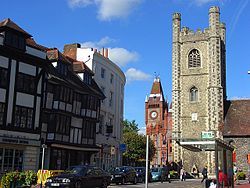 St Lawrence's Church, Reading Town Centre | |
| Location | |
| Grid reference: | SU713733 |
| Location: | 51°27’15"N, -0°58’23"W |
| Data | |
| Population: | 143,096 (2001) |
| Post town: | Reading |
| Postcode: | RG1, RG2, RG4, RG6, RG8, RG10, RG30, RG31 |
| Dialling code: | 0118 |
| Local Government | |
| Council: | Reading |
| Parliamentary constituency: |
Reading East, Reading West |
| Website: | www.reading.gov.uk |
Reading is the largest town of Berkshire. It stands on the south bank of the River Thames, where the River Kennet enters it, some 40 miles west of London. Reading is well connected, by the M4 motorway, the Great Western Main Line railway and the M4 motorway.
Reading was an important national centre in the mediæval period, the site of a monastery with strong royal connections. Today it remains a commercial centre, with links to information technology and insurance.
Reading also hosts two universities, a large student population, and is home to one of Britain's biggest music festivals.
It was reported that Reading has 127 different spoken languages within its population, and therefore (for its population size) unrivalled in the world with regards to number of languages spoken in one town.[1]
History
Beginnings
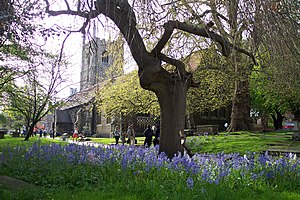
The settlement was founded at the confluence of the River Thames and River Kennet in the 8th century as Readingum (dative plural: the nominative would be ‘’Readingas), from an Anglo-Saxon tribe whose name means "Reada's People"[2] or (less probably) the Celtic Rhydd-Inge, "Ford over the River".
In late 870 an army of Danes set up camp at Reading, and on 4 January 871, the Battle of Reading took place, when an army lead by King Æthelræd and his brother Alfred sought unsuccessfully to breach the Danes' defences. The battle is described in the Anglo-Saxon Chronicle, and this account provides the earliest known written record of the existence of the town of Reading. The Danes retreated from Reading in late 871 to winter quarters in London.[3]
By the time of its 1086 Domesday Book listing, the town had grown to contain around 600 people and was a designated borough.
Time of the Abbey
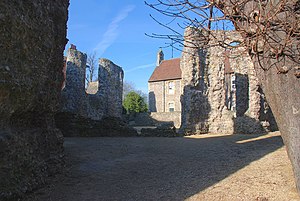
The foundation of Reading Abbey by King Henry I in 1121, where he was also buried, led to the town becoming a place of pilgrimage. Already acknowledged as a borough by this time, the relationship between the town's burgesses and the Abbey was to prove strained at times. In 1253 Reading's Merchant Guild successfully petitioned for the grant of a charter from the King and negotiated a division of authority with the Abbey. However disputes continued over the Abbey's powers to raise taxes and appoint the Guild's officers. Even the title of the Guild's first officer was open to dispute, with the Guild and, on occasion, the King referring to him as the Mayor, whilst the Abbey continued to call him the Guild Warden.[4]
The mediaeval borough of Reading was served by three parish churches. Besides Reading Minster, these were St Giles' and St Laurence's churches, both of which are still in use as Anglican churches. The Franciscan|Franciscan friars built a friary in the town in 1311 and after the friars were expelled in 1538, the building was used as a hospital, a poorhouse and a gaol, before being restored as a parish church, Greyfriars Church, in 1863.
It is not known exactly how badly Reading was affected by the Black Death that swept through England in the 14th century, but it is known that the abbot of Reading Abbey was one of its victims in 1361, and that nearby Henley-on-Thames lost 60% of its population.[5]
In 1487, Henry VII granted a further charter that went further than previous charters, although still leaving the appointment of the Mayor or Warden in the hands of the Abbey. This charter, and a subsequent judicial arbitration in 1499, confirmed the Guild as a body corporate in perpetuity.[6]
Dissolution and war
The Abbey was largely destroyed in 1538 during the Dissolution of the Monasteries. The last abbot, Hugh Cook Faringdon, was subsequently tried and convicted of high treason and hanged, drawn and quartered in front of the Abbey Church. The dissolution initially saw the Mayor appointed by the King's officers administering the dismemberment of the abbey properties. However, in 1542 King Henry VIII granted the Guild a new charter that permitted the burgesses to elect the Mayor.[6][7]
By 1525, Reading was the largest town in Berkshire, and tax returns show that Reading was the 10th largest town in England, based on taxable wealth. By 1611, Reading had a population of over 5,000 and had grown rich on its trade in cloth, as instanced by the fortune made by local merchant, John Kendrick.[5]
At this time, Reading had mostly traditional timber framed houses, a few examples of which still exist in Castle Street, Market Place and other places. Often the front ground floor of the house was given over to retail activities, with family and lodgers living in the rooms behind and above.[8]
The town played an important role during the English Civil War; it changed hands a number of times. Despite its fortifications, it had a Royalist garrison imposed on it in 1642. The subsequent Siege of Reading by the Parliamentary forces succeeded in April 1643. However, the taxes levied on the town by the garrison badly damaged its cloth trade, and it did not recover.[9]
Reading was also the only site of significant fighting in England during the Glorious Revolution of 1688, with the second Battle of Reading.[10]
18th century
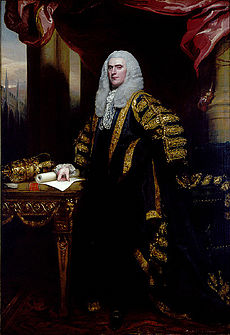
The 18th century saw the beginning of a major iron works in the town and the growth of the brewing trade for which Reading was to become famous. Agricultural products from the surrounding area still used Reading as a market place, especially at the famous Reading cheese fair but now trade was coming in from a wider area.
Reading's trade benefited from better designed turnpike roads which helped it establish its location on the major coaching routes from London to Oxford and the west country. It also gained from increasing river traffic on both the Thames and Kennet. In 1723, despite considerable local opposition, the Kennet Navigation opened the River Kennet to boats as far as Newbury. This opposition stopped when it became apparent the new route benefited the town. The opening of the Kennet and Avon Canal in 1810 made it possible to go by barge from Reading to the Bristol Channel.
From 1714, and probably earlier, the role of county town for Berkshire was shared between Reading and Abingdon. The Assizes and the Quarter Sessions met in both towns, with the Lenten Assizes traditional held in Reading and the Summer Assizes in Abingdon. The county gaol was at Reading, but both had a house of correction, also known as a “Bridewell”, that held prisoners from various parts of the county.[11]
Towards the end of the century, Henry Addington, 1st Viscount Sidmouth, lived at Bulmershe Court, in what is now the Reading suburb of Woodley. Although he moved to Richmond when he was appointed prime minister, he retained his local connections. He donated to the town of Reading the four acres of land that is today the Royal Berkshire Hospital, and his name is commemorated in the town's Sidmouth Street and Addington Road.[12][13]
19th century
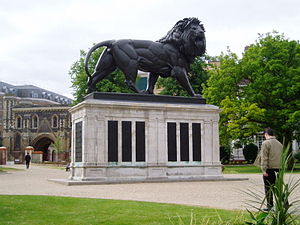
In 1801, the population of Reading was about 9,400. During the 19th century, the town grew rapidly as a manufacturing centre. Reading maintained its representation by two Members of Parliament with the Reform Act 1832, and the borough was one of the ones reformed as a municipal borough by the Municipal Corporations Act 1835. In 1836 the Reading Borough Police were founded. The Great Western Railway arrived in 1841, followed by the South Eastern Railway, in 1849, and the London and South Western Railway, in 1856.
The Reading Establishment, an early commercial photographic studio, operated in Reading from 1844 to 1847 and was managed by Nicholaas Henneman, a Dutchman and former valet of William Henry Fox Talbot (the pioneer of photography). Many of the images for The Pencil of Nature by Fox Talbot, the first book to be illustrated with photographic prints, were printed in Reading.[14]
In 1851 the population was 21,500. The Summer Assizes were moved from Abingdon to Reading in 1867, effectively making Reading the leading town of Berkshire, a decision that was officially approved by the Privy Council in 1869.[15] The town became a county borough under the Local Government Act 1888. By 1900, the population was 59,000—large sections of the housing in Reading are terraced house|terraced, reflecting its 19th century growth. The town has been famous for the "Three Bs" of beer (from 1785 dominated by the Simonds' Brewery), bulbs (1807–1976, Suttons Seeds), and biscuits (1822–1977, Huntley & Palmers). In the 19th century the town also made 'Reading Sauce', described as a sharp sauce flavoured with onions, spices, and herbs, very much like Worcestershire Sauce.
20th century and beyond
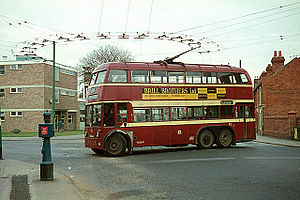
The town continued to expand in the 20th century, the townscape spreading over the bridge to Caversham in Oxfordshire in 1911. This expansion can be seen in the number of 1920s built semi-detached properties, and the 1950s expansion that joined Woodley, Earley and Tilehurst into Reading. Miles Aircraft in Woodley was an important local firm from the 1930s to 1950s. The Lower Earley development, started in the 1970s, was the largest private housing development in Europe. This extended the urban area of Reading up to the M4 motorway, which acts as the southern boundary to the town. Further housing developments have increased the number of modern commuter houses in the surrounding parts of Reading, and 'out-of-town' shopping hypermarkets.
At the end of 1966 the Yield Hall multi-storey car park was opened, providing covered space for 522 cars.[16] It was noted that the ramps were arranged to segregate up-traffic from down-traffic, with "one-way circulation" through most of the building.[16]
The local shopping centre, The Oracle, built in 1999, is named after the 17th century workhouse founded by John Kendrick which previously occupied the site. It provides three storeys of shopping and boosted the local economy by providing 4,000 jobs. Reading has pedestrianised Broad Street.
Churches
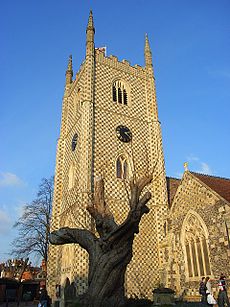
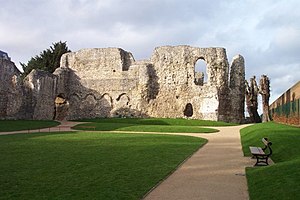
- Church of England:
- Reading Minster (the Minster Church of St Mary the Virgin), Reading's oldest ecclesiastical foundation, founded by the 9th century and possibly earlier.
- Greyfriars Church
- several parish churches
- Roman Catholic Church: St James' Church (built on part of the abbey site between 1837 and 1840)
Other religions
- Buddhist: Mahayana Buddhist Centre "Shantideva"
- Islam: Central Reading Mosquein Waylen Street
Economy
Reading is an important commercial centre in southern England and is often referred to as the commercial capital of the Thames Valley. The town hosts the headquarters of British companies and the UK offices of foreign multinationals, as well as being a major retail centre.[17]
Culture
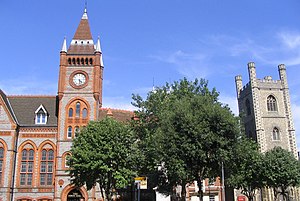
Music
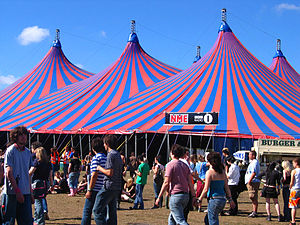
Every year Reading hosts the Reading Festival, which has been running since 1971. The festival takes place on the Friday, Saturday and Sunday of the August bank holiday weekend. Since 1999, Reading has been twinned with a simultaneous festival in Leeds, with the same acts appearing at both festivals on different days. In 2005, the main festival spawned the Reading Fringe Festival. Set up by a group of musicians, promoters, film-makers and artists, and now in its 6th year, to help showcase acts and performers in the towns venues in the run-up to the main festival.
For some twenty years up until 2006, Reading was also known for its WOMAD festival. However the event eventually outgrew its Rivermead site. As of 2007, amid much controversy,[18] the event relocated to Wiltshire in the form of Womad Charlton Park.[18][19][20] The Head of Culture, Chris Smith - tasked with keeping WOMAD in Reading - was on holiday at the time of the announcement that WOMAD was to move. He later took a senior job with WOMAD.[21]
Perhaps the most notable home-grown artist is Mike Oldfield of Tubular Bells fame. Slowdive, The Cooper Temple Clause, Stuart Price, Morning Runner, My Luminaries, Does It Offend You, Yeah?, OK Tokyo, Dan Le Sac Vs. Scroobius Pip, Pete & The Pirates, SixNationState, Pure Reason Revolution, Exit Ten, Sylosis, Malefice, The Arusha Accord, Bennet and Mr Fogg have had some degree of success. Left-field experimental pop band Lemon Kittens also started life here in the late '70s, and 60s folk/blues legend-turned-avant-gardist Mike Cooper also. David Byron, first and most famous singer of hard rock band Uriah Heep lived his last years in Reading before he died in 1985. The Chemical Brothers attended Reading Blue Coat School. Lead singer of 'odd-pop' group The Hoosiers Irwin Sparkes is from Woodley. He supports Reading FC and in the music video for The Hoosiers' song 'Goodbye Mr. A', he can be seen playing as the team on a football game.
Reading plays host to semi-professional and amateur choirs and choral societies. Reading Festival Chorus has celebrated its 60th anniversary. RFC sings a diverse music programme, with works such as Mozart's Requiem, Karl Jenkins' The Armed Man in 2005 to Beethoven's Missa Solemnis and a summer programme of English and American Folk songs by Tippett and Aaron Copland.
Reading has several orchestras. The long-established Reading Symphony Orchestra (RSO)[22] is one of the town's amateur orchestras, led by a professional conductor and leader. It presents four main concerts a year, and is often engaged to work in collaboration with other musical organisations and for private functions. The Aldworth Philharmonic Orchestra (APO),[23] founded in 2002 and named after Richard Aldworth, the founder of Reading Blue Coat School, rehearses and plays most of its concerts at the school. APO's remit is to be as innovative as possible, giving local people the chance to play by rehearsing exclusively at weekends, attracting a wider audience to classical music (especially younger people) through its 'Concert Virgin Scheme' and education projects, and championing the music of talented young composers. Reading Youth Orchestra (RYO) provides an opportunity for younger musicians.
Theatre
- Professional theatre:
- Amateur theatre venues:
References
- ↑ "The Town With 127 Tongues.". The Sun. 2010-02-09. http://www.thesun.co.uk/sol/homepage/news/2845343/Reading-is-the-town-with-127-different-languages.html. Retrieved February 9, 2010.
- ↑ Cameron, Kenneth (1961). English Place Names. Taylor & Francis. p. 64. http://books.google.com/?id=FkYOAAAAQAAJ&pg=PA64.
- ↑ Phillips, Daphne (1980). The Story of Reading. Countryside Books. pp. 14–15. ISBN 0-905392-07-8.
- ↑ Slade, Cecil (2001). The Town of Reading and its Abbey. MRM Associates Ltd. pp. 1–16. ISBN 0-9517719-4-9.
- ↑ 5.0 5.1 Hylton, Stuart (2007). A History of Reading. Philimore & Co Ltd. pp. 34–38. ISBN 978-1-86077-458-4.
- ↑ 6.0 6.1 Slade, Cecil (2001). The Town of Reading and its Abbey. MRM Associates Ltd. pp. 17–25. ISBN 0-9517719-4-9.
- ↑ The staff of the Trust for Wessex Archeology and Reading Museum and Art Gallery (1983). Reading Abbey Rediscovered, a summary of the Abbey's history and recent archaeological excavations. Trust for Wessex Archeology.
- ↑ Hylton, Stuart (2007). A History of Reading. Philimore & Co Ltd. pp. 51–52. ISBN 978-1-86077-458-4.
- ↑ Ford, David Nash. "The Siege of Reading". Royal Berkshire History. Nash Ford Publishing. http://www.berkshirehistory.com/articles/reading_siege.html. Retrieved 2009-04-27.
- ↑ Ford, David Nash. "The Battle of Broad Street". Royal Berkshire History. Nash Ford Publishing. http://www.berkshirehistory.com/articles/reading_broadst.html. Retrieved 2009-04-27.
- ↑ Hunter, Judith (1995). A History of Berkshire. Chichester: Phillimore. p. 103. ISBN 0 85033 729 1.
- ↑ Ford, David Nash. "Henry Addington, Viscount Sidmouth (1757-1844)". Royal Berkshire History. Nash Ford Publishing. http://www.berkshirehistory.com/bios/haddington.html. Retrieved 2009-05-04.
- ↑ "Royal Berkshire Hospital". Royal Berkshire NHS Foundation Trust. http://www.royalberkshire.nhs.uk/about_us/our_locations/royal_berkshire_hospital.aspx. Retrieved 2009-05-04.
- ↑ "Fox-Talbot, William Henry (1800–77), pioneering photographer". Reading Borough Libraries. http://www.readinglibraries.org.uk/services/local/foxtalbot.htm. Retrieved 2007-05-21.
- ↑ "Berkshire Quarter Sessions". Jackson's Oxford Journal. 4 July 1868.
- ↑ 16.0 16.1 News and views: Parking in Reading; Autocar magazine vol 125 (nbr 3697) page 1341, 23 December 1966
- ↑ "Vision for Reading Chamber of Commerce". Thames Valley Chamber of Commerce. http://www.thamesvalleychamber.co.uk/memberservices/readingvision.asp. Retrieved 2008-06-11.
- ↑ 18.0 18.1 "battle to keep womad revealed". Reading Evening Post. http://www.getreading.co.uk/news/s/2004686_battle_to_keep_womad_revealed. Retrieved October 3, 2006.
- ↑ Schofield, Deborah (2002-08-05). "WOMAD in Reading". London: Guardian Unlimited - Arts. http://arts.guardian.co.uk/features/story/0,,765215,00.html. Retrieved July 6, 2006.
- ↑ "Womad venue change after 17 years". BBC News. 2006-10-03. http://news.bbc.co.uk/1/hi/england/berkshire/5403836.stm. Retrieved October 20, 2006.
- ↑ "WOMAD Abu Dhabi". Reading Evening Post. http://womad.org/news/womad-presents-womad-abu-dhabi-april-2009. Retrieved October 21, 2009.
- ↑ "Reading Symphony Orchestra". Rso.org.uk. http://www.rso.org.uk. Retrieved 2010-07-26.
- ↑ "Aldworth Philharmonic Orchestra - Home Page". Aldworthphilharmonic.org.uk. http://aldworthphilharmonic.org.uk. Retrieved 2010-07-26.
- ↑ "The Hexagon, Reading Arts". http://www.readingarts.com/thehexagon.
- ↑ "21 South Street, Reading Arts". http://www.readingarts.com/southstreet. Retrieved 14 March 2007.
- ↑ "Progress Theatre homepage". http://www.progresstheatre.co.uk. Retrieved 15 March 2007.
- ↑ "Progress Theatre, Reading Arts". http://www.readingarts.com/othervenues/theprogresstheatre. Retrieved 14 March 2007.
- ↑ "Progress Theatre Open Air Shakespeare". http://www.progresstheatre.co.uk/index.php?option=com_content&task=category§ionid=6&id=30&Itemid=50. Retrieved 14 March 2007.